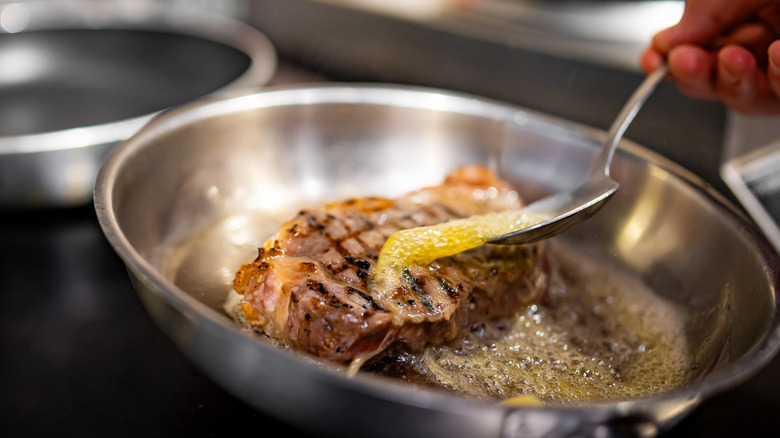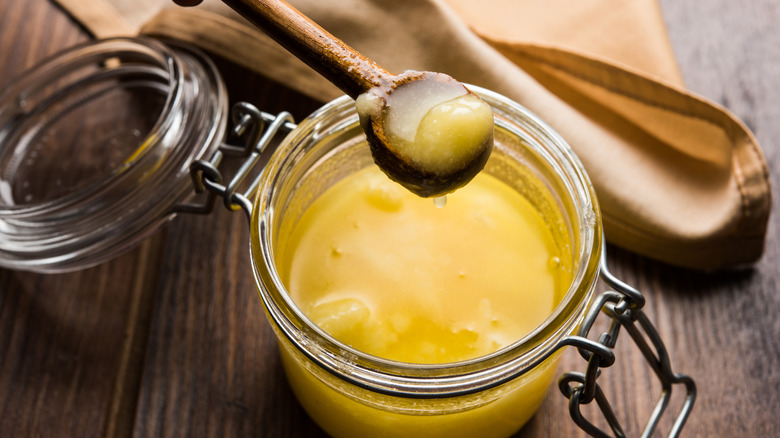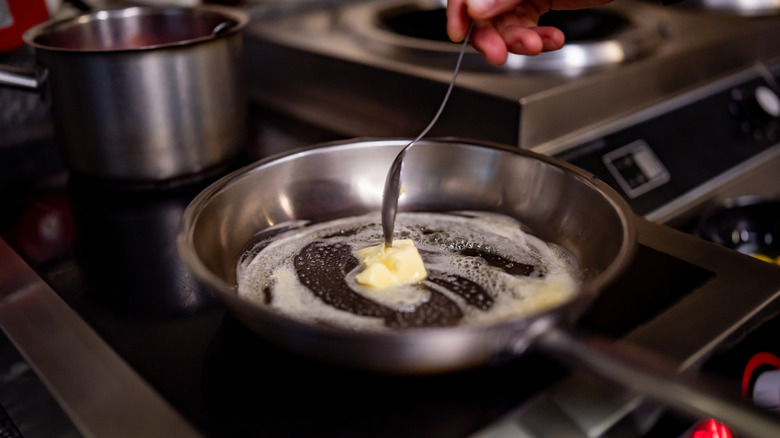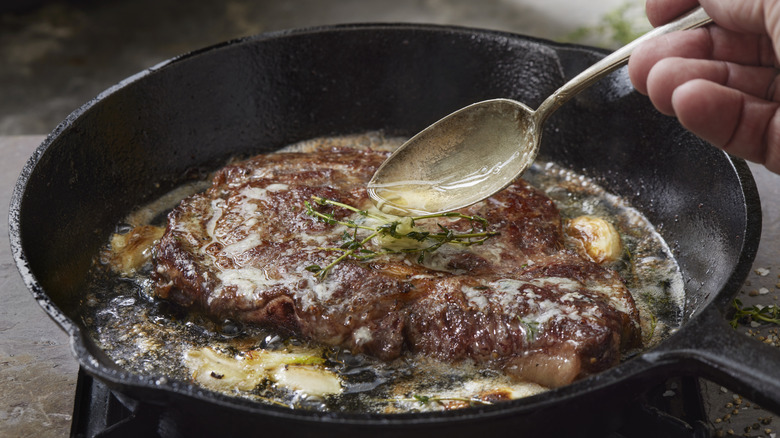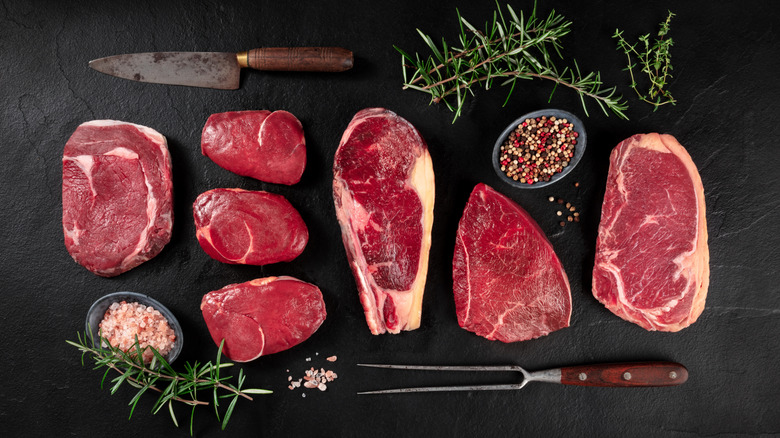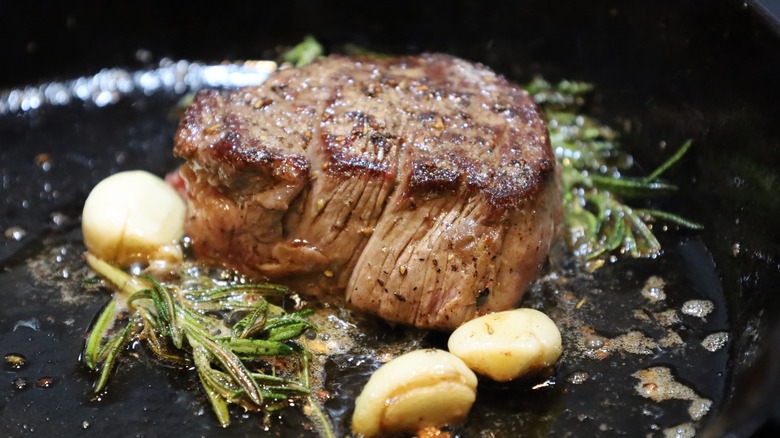The Mistakes You Should Avoid When Butter-Basting Steak
With so many ways to cook a steak and so many different cuts to master, making the most of a specific technique can be hard if you don't know what mistakes to avoid. One of the most common, yet easily messed up cooking methods is butter basting your steak: spooning butter over the meat as it cooks to tenderize it and add flavor. While there are many tips out there, Food Republic spoke to Dominick Pepe, executive chef at Rocco's Steakhouse, to learn how to properly butter baste.
The first thing to know is that butter basting is not a form of cooking, but a means of adding flavor — hence why it occurs near the end of the cooking process. Pepe said, "For optimal results, I would finish the steak by basting with butter. I recommend starting the sear in a neutral, high smoke point oil such as non-seed oil or avocado oil, and then introducing the butter towards the end of the cooking process to baste and finish the steak."
Butter basting requires patience, but when it's go-time, the greatest mistakes often come from not monitoring the temperature and smoke levels, and not knowing what the best cuts of steak are and how to cook them – some steaks, like hanger, need hot and fast cooking after all. Butter basting will put all five of your senses to the test, but when done correctly, you'll want to use this flavoring method every time. Just know which mistakes you should avoid at all costs.
Mistake 1: Using non-clarified butter
According to Dominick Pepe, "The most common mistake home cooks make when butter basting steaks is burning the butter because it has a low smoke point." You need a high heat sear, but using the wrong butter won't get you there. "To avoid this," Pepe said, "use clarified butter, which involves removing the oil and milk fat, effectively doubling the smoke point and allowing for a better sear without burning."
To clarify your butter, you'll want to slowly melt it into its own pan until the milk fat separates and can be skimmed away from the surface. You're left with a bright yellow butter liquid that can withstand more heat, yet still bring the flavor to your steak. Essentially, you're making liquid gold, aka ghee.
Mistake 2: Your butter isn't hot enough
Once you've clarified your butter, you'll be able to heat it to a level that actually yields the results you want — but only when it's hot enough. Dominick Pepe said, "You want a higher smoke point to oxidize the molecules for better flavor development. If the butter isn't hot enough, you won't get a sufficient sear."
Just remember that it is possible to burn your butter, so Pepe recommended keeping your pan hot enough to hear the sizzle, but have no visible smoke rising. It's about balancing enough heat for the oils in the butter to create a good sear without going over the smoke point, which is about 450 degrees Fahrenheit.
Mistake 3: Improper spooning technique
It's the little things that make a recipe successful, and proper spooning technique is key to good butter basting. For the most even coating and flavor distribution, Dominick Pepe said to tilt "the pan at approximately a 35-degree angle and then [spoon] the butter upwards and away from yourself."
Not only is this the safest method for you when working with a hot pan, but the angle helps the butter naturally spread. "This technique allows the butter to pool at the tilted edge and then roll back towards you, enabling you to baste the steak by continuously spooning the hot butter over the top," Pepe explained.
Mistake 4: Not knowing your meat
There's a reason flank steak is the best cut of meat for pepper steak, and why filet mignon isn't served in small strips for stir fry. Knowing your steak cut's properties is also key for successful basting, and tells you which steaks to baste in the first place.
According to Dominick Pepe, "The thicker the cut, the better the sear you can achieve while basting. If the steak is too thin, it will cook too quickly, and you won't have enough time to develop a good sear through basting without overcooking the interior." So, note that you'll want to invest in thicker or denser cuts of meat for butter basting, so the butter has enough time to fully seep into the steak without burning.
Even so, don't go overboard and try to baste a bone-in steak. Anything too thick risks burning even clarified butter "before the center [of the steak] reaches the desired temperature," Pepe informed us.
Mistake 5: Forgetting the additional seasonings
Butter is a great flavoring agent, but as Dominick Pepe reminded us, one final "mistake is not adding aromatics to the butter to enhance the flavor beyond just the butter itself." You would likely season your steak when using other cooking methods, and butter basting is no exception. "Incorporating raw garlic and thyme while basting infuses the butter, which in turn flavors the steak, imparting a deeper and more complex taste," said Pepe.
This is also your chance to experiment with new flavors for your buttery steak, like adding pepper flakes or Cajun spices, to give you the most tender and flavor-packed end result.

